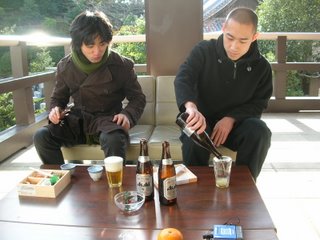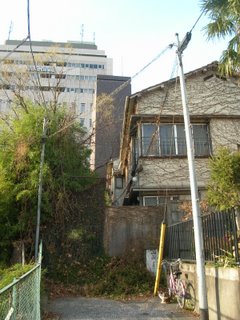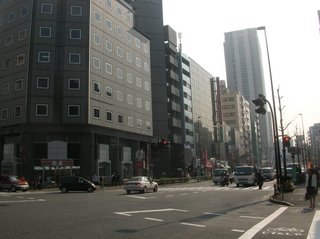posted on Feb 14, 06 Pic:Tokyo Tower
Pic:Tokyo TowerOkay, it is my first journal. Since our class focuses on “
Tokyo”, I think I should start my journal from Image of Tokyo.
I was bone in Tokyo (city area), and grew up in Tokyo. I have no experience of living in out side of Tokyo. Thus, my image of Tokyo might be different from the people from out side of Tokyo.
What is your image of Tokyo???Big?
Clean?
Safe?
Crowded trains?
Expensive for living?
These are all I heard from study abroad students.
ORBrilliant?
Place to anticipate dreams?
No one cares about others (people are frosty to others)?
Dangerous?
Schoolgirl prostitution?
Foul air?
No nature?
These are all I heard from Japanese people who came from out side of Tokyo.
I agree some points, and I do not agree many points.
First of all, you need to know that Tokyo Metropolis dose not mean “Tokyo” in general.
Tokyo Metropolis can be divided into three parts, which are City part, middle part, and mountains part.
In general, “Tokyo” means the city part.Many people live in middle part because it is cheap for living, and commute to city part for work (by crowded trains/ car is not popular for transportation).
Both people living in city and middle part ironically call middle part “Country side of Tokyo.”
So, in this journal I will write about city area of Tokyo where I am living.
Is Tokyo big, clean, and safe city?Not really.
There are great transportations; we can go to everywhere of Tokyo by trains and basses.
I agree that Tokyo is clean. That is because there is common senesce that we need to keep our city clean. In fact, my neighbor cautioned me to sweep because I did not clean up dead leaves of my acorn tree on the road in front of my house. When I was in junior high, we had “cleaning activity” for community service.
Tokyo is not safe city. Of cause, compare to other country, Japan is safe (I do not know, but that’s what I heard); however, compare to other part of Japan, Tokyo is not really safe city.
Are there too many people in Tokyo?I agree and disagree. On daytime, there are too many people in Tokyo, but most of the peoples are from middle part of Tokyo and other prefectures. They came for work and visit. Not many peoples are actually living in Tokyo.
Tokyo is expensive to live. Yes, definitely, but it does not means people living in Tokyo are rich. Like my family, people are living in Tokyo from grand or grand-grand mothers age. We have own house in Tokyo, so we are living in Tokyo.
Tokyo is brilliant.Yeah, there are a lot of lights on the road.
Tokyo is place to anticipate dreams?Well, Since Tokyo is center of the Japanese economy, there are much more chance to anticipate dreams than other part of Japan, I think.
People in Tokyo are frosty to others.I am not. But it is hard to make relationships in small community because there are varieties of people in Tokyo.
Tokyo is dangerous?As I wrote above, compare to other part of Japan, Tokyo is more dangerous.
Schoolgirl prostitution?Not all of schoolgirls do of cause. Just media pick up the topic, and exaggerated.
Foul air?Yes, exactly.
No nature?Not really, but all greens are “made” by human. There are no natural greens.
These are my reflections to the images of Tokyo.
It was interesting because depends on what city or town you compare with, image of Tokyo can be 180 degree different. (Study abroad studens/ people living in other part of Japan.)
It is hard for me to define what is my image of Tokyo because I do not have many experiences to compare. Tokyo is just a city where I grew up. I have both complaints and favorite tings about Tokyo. I love this city.
so what is your image of Tokyo?















